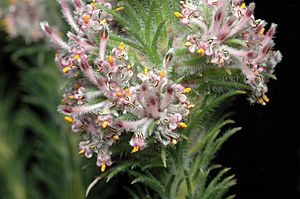Isopogon inconspicuus facts for kids
Quick facts for kids Isopogon inconspicuus |
|
|---|---|
 |
|
| In the ANBG | |
| Scientific classification | |
| Genus: |
Isopogon
|
| Species: |
inconspicuus
|
| Synonyms | |
|
|
Isopogon inconspicuus is a special plant. It belongs to the Proteaceae family. This plant is found only in the southwest part of Western Australia. It's a small shrub with unique leaves. Its flowers are pink to purple and covered with soft grey hairs.
What Does This Plant Look Like?
Isopogon inconspicuus is a small shrub. It usually grows to be about 20 to 80 centimeters tall. Its small branches are covered with soft, woolly hairs. These hairs can be brownish or greyish.
The leaves of this plant are close together. They are about 10 to 12 millimeters long. The leaves are "pinnate," which means they have leaflets arranged like a feather. These leaflets are shaped like tiny cylinders. They grow on a short stalk called a petiole, which is up to 2 millimeters long.
The flowers grow in round heads. These heads are about 25 to 30 millimeters long. They sit directly on the stem without a stalk, which is called "sessile." The flower heads are often found near the ends of the branches. Each head has pink to purple flowers. These flowers are about 25 millimeters long. They usually hang downwards and are covered with grey hairs.
This plant blooms from August to November. After flowering, it produces fruit. The fruit is a small, hairy nut. It is about 3 millimeters long. Many of these nuts join together. They form a larger, oval or round head. This head can be 15 to 20 millimeters wide.
How It Got Its Name
This plant was first officially described in 1855. A botanist named Carl Meissner gave it a name. He called it Petrophile inconspicua. He wrote about it in a science journal. The journal was called Hooker's Journal of Botany and Kew Garden Miscellany. Meissner studied plant samples collected by James Drummond.
Later, in 1995, another botanist changed its name. Donald Bruce Foreman changed it to Isopogon inconspicuus. This new name was published in a book series. The series is called Flora of Australia.
Where Does It Grow?
Isopogon inconspicuus grows in special places. It likes sandy areas called "sandplains." You can find it in heathlands and shrublands. These areas are between the towns of Dandaragan and Eneabba. Both towns are in Western Australia.

